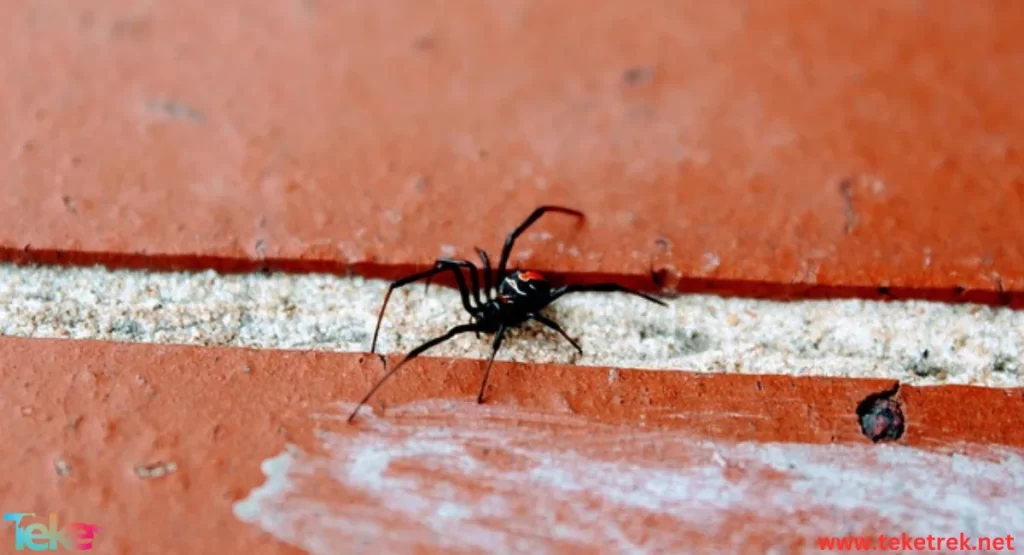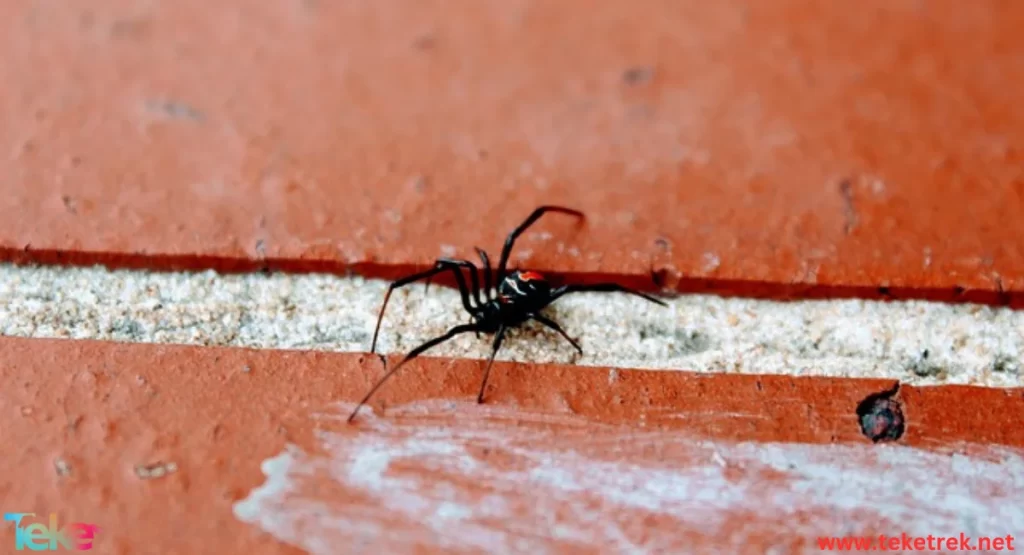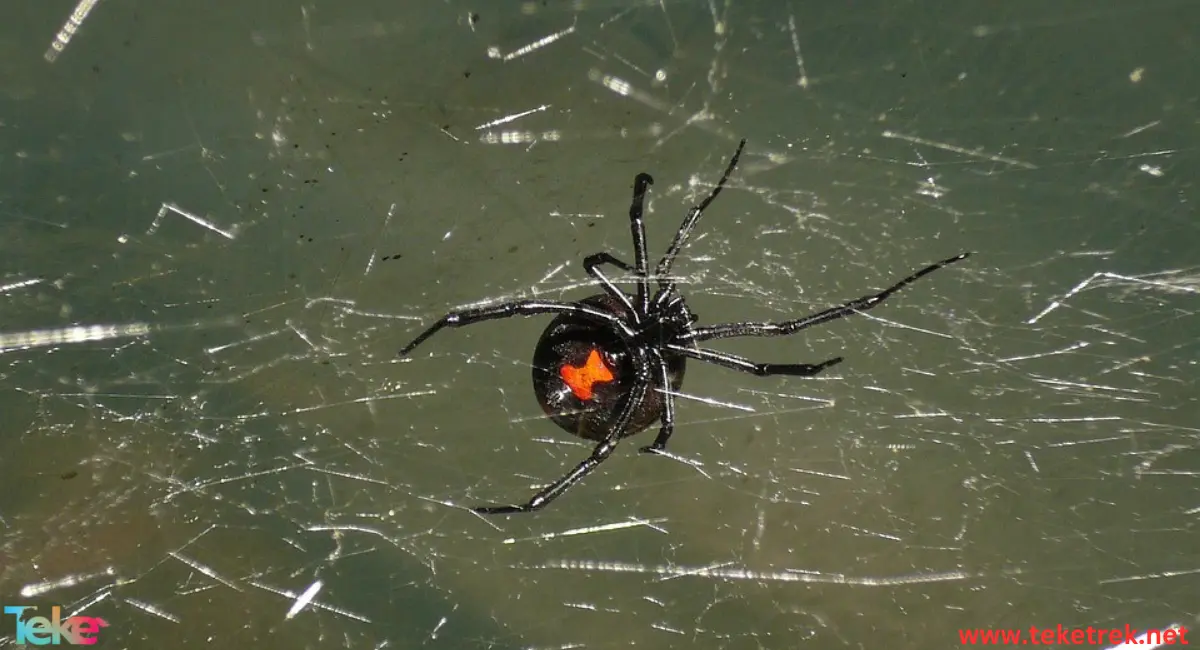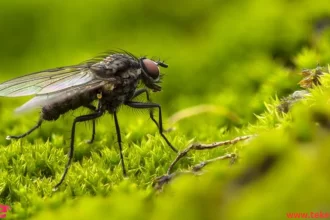This black widow spider is found worldwide and is commonly associated with urban habitats or agricultural areas. The name “black widow spider” most commonly refers to three North American species known for their dark coloration, black hair, and red hourglass pattern. However, there are 31 recognized species within the Latrodectus genus, including the Australian red-back, brown widow spider (sometimes called the grey widow), and the red widow spider. While in South Africa they are known as “button spiders”.
In this article in TekeTrek Website, we will introduce you to the most important information related to this object. Follow along with us.
Key characteristics of the black widow spider
Appearance:
- Female black widow spiders are shiny black when fully grown. They often exhibit a red or orange hourglass marking on the ventral surface (underside) of the abdomen.
- The bodies of black widow spiders range from 3–10 mm (0.12–0.39 in) in size, with some females measuring up to 13 mm (0.51 in) in body length (excluding legs).
- Male black widow spiders are smaller than females and usually have various red or red-and-white markings on the dorsal surface (upper side) of the abdomen. Juveniles resemble the male pattern.
- Adult males can be distinguished from juvenile females by their slenderer body, longer legs, and large pedipalps (appendages typical of most male spiders).
- The colorful markings warn predators animal, Eating a black widow spider will not normally kill a small predator (such as birds), but the sickness that follows digestion acts as a deterrent.
Venom and Feeding:

- Black widow spiders primarily feed on small insects such as flies, cockroaches, ants, and wasps. They also occasionally prey on other spiders.
- They capture prey by weaving intricate three-dimensional webs and waiting for their victims.
- The venom of black widow spiders contains the neurotoxin latrotoxin, which causes the condition known as latrodectism. Although potent, black widow bites rarely cause death or serious complications in humans. Only the bites of females are dangerous to humans.
Habitat and Distribution
- The original habitat of black widow spiders is believed to be tropical and temperate regions of the Americas.
- They are found in areas such as the southeastern United States, extending to Ohio in the north and Texas in the west. They are also present in Mexico.
- Black widow spiders prefer warm and humid environments, including farms and urban areas.
Reproduction


Black widow spider is non mammal animal,it reproduce by laying eggs:
- Males create a web for sperm transfer and deposit seminal fluid on it for mating with females.
- Females produce egg sacs inside silk cocoons, protecting and guarding them. Each egg sac contains 100 to 400 eggs, which hatch after about 20-30 days.
- Survival rates for the eggs are low due to cannibalism among spiderlings and limited food availability.
- Black widow spiders take 2 to 4 months to mature for reproduction.
Venom and Danger
- The venom of female black widow spiders can be injected into humans and is particularly harmful to large vertebrates, including humans.
- Symptoms of a black widow bite include severe pain, muscle contractions, and an increase in body temperature.
- Despite their reputation, fatalities from black widow bites are rare in healthy adults.
Mating Behavior
- Females often consume their mates after mating, which is why they are called “widows.”
- Reasons for this behavior include additional food sources for the female, increased genetic success, control of male competition, and biological factors.
The most faqs about the black widow spider
- Who is the Black Widow and why was she given this name?
It is called black because of its color, while the widow is because she kills her partner after mating. * Females live on average for 3 years, while males are less fortunate and live for only a month or two. The black widow loves to stay in dark places, which makes her invisible, especially because of her color
- How bad is a black widow bite?
Complications A single bite from a widow spider or monk spider may cause death in rare cases, especially to young children. A deep wound resulting from a widow spider bite may take several weeks or months to heal and leave significant scarring.
- What does black widow venom cause?
A black widow bite usually causes sharp pain, somewhat like a pinprick, followed by dull pain and sometimes numbness in the area around the bite. Cramping pain and muscle stiffness, which may be severe, occur in the abdomen, shoulders, back, and chest.
- What does the black widow feed on?
The northern black widow usually feeds on other arthropods and has no direct effect on plants.
- How do you know a black widow?
Glossy black body with long legs red hourglass shape on belly Full body length, including legs, is approximately 1 inch (2.5 cm)
- Is the black widow aggressive?
Black widow spiders are not aggressive and do not attack humans except in case of self-defense, such as when someone harms them or tries to crush them by mistake.
- What kind of animal is a black widow?
the black widow spide belongs the spider family.
- Is A black widow a bird?
It does not belong to the spider family.
In conclusion, understanding the black widow spider is essential for respecting and preserving biodiversity. Despite their danger, these spiders play a crucial role in regulating ecosystems and controlling harmful insects. Let’s continue to learn and appreciate the natural world, even when encountering creatures that may seem frightening at first. Preserving biodiversity contributes to the overall health of our planet.






